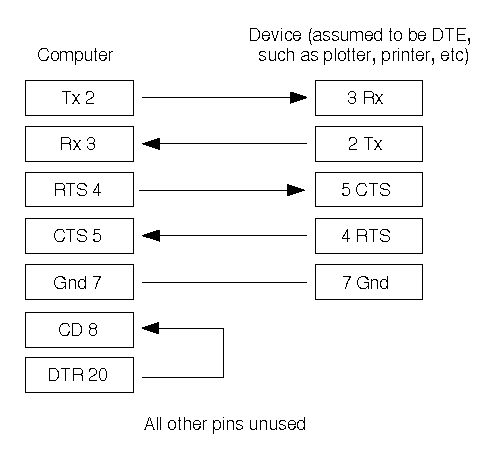Setting up RTS/CTS protocol (hardware flow control) printers
The Ready To Send (RTS) and Clear To Send
(CTS) lines for the
RS-232 serial interface were originally intended
as handshaking signals between a DTE device
(computer, printer, and so forth) and a DCE
device (almost always a modem). This section describes
unidirectional handshaking between two DTE devices: a
computer and a printer. The computer asserts its
RTS (Ready To Send) line when it is
ready to send data to the printer. The printer
asserts its RTS when it was ready to receive data.
If the printer's input buffer is nearly full,
it lowers its RTS line (connected to the computer's
CTS (Clear To Send) line).
If the computer sees CTS go low,
it stops sending data until it goes high again when the printer
has caught up.
Some printers use the DTR (Data Terminal Ready)
line for handshaking rather than RTS or
CTS. For these devices, the cable must be wired
to connect the printer's DTR pin to the
computer's CTS pin -- see
``DTR handshaking for 25-pin connector''.
To set up for RTS/CTS handshaking:
-
Use the modem-control port (such as /dev/tty1A).
When you configure the printer to use the print service,
make sure you specify the modem control
port rather than one of the standard serial devices.
-
For a device that uses the RTS and/or
CTS lines for handshaking, wire the cable
as shown in
``RTS/CTS handshaking for 25-pin connector''.
For a device that uses the DTR line for
handshaking, wire the cable as shown in
``DTR handshaking for 25-pin connector''.
For equivalent 9-pin connections, see the
serial(HW)
manual page.

RTS/CTS handshaking for 25-pin connector

DTR handshaking for 25-pin connector
-
To enable unidirectional hardware flow control using
RTS/CTS handshaking, make sure the
stty(C)
settings on the port include
-ixon -ixoff -clocal ortsfl rtsflow ctsflow.
To enable unidirectional hardware flow control using
DTR handshaking, make sure the
stty(C)
settings on the port include
-ixon -ixoff -clocal -ortsfl -rtsflow ctsflow.
This form of unidirectional flow control stops transmission when
CTS sees the printer drop DTR.
To enable the stty settings when the system goes to
multiuser mode, place the appropriate command
in the file /etc/rc2 or /etc/rc2.d/P88USRDEFINE:
stty stty_settings < /dev/ttynn
Previous topic:
Troubleshooting printers
© 2003 Caldera International, Inc. All rights reserved.
SCO OpenServer Release 5.0.7 -- 11 February 2003

